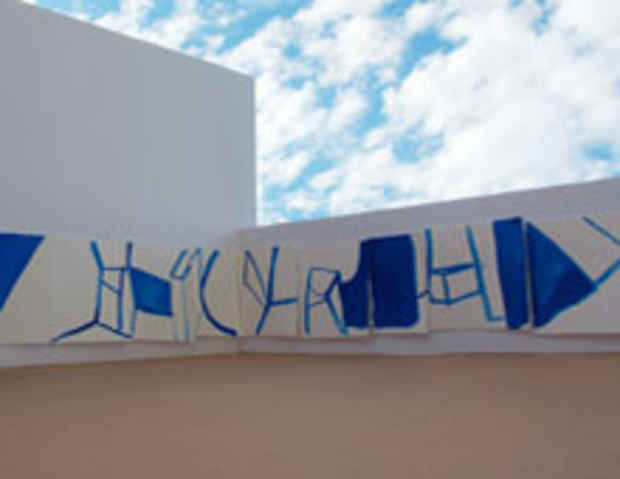Elizabeth Jobim "Endless Lines"
Lehman College Art Gallery

This event has ended.
Where does the work start and where does it end? Is there a beginning or a finishing point? An intermittent flow of blue lines and volumes takes over the white spaces of the canvases. Little by little they engulf their surroundings to create an architectural environment. Cut and continuity, flow and interruption, partial dwellings and total nests, restful and activated spaces made out of lines that continually advance and intrude from canvas to canvas. Elizabeth Jobim’s work is in a state of process, in a permanent flux, always unfolding into new forms, either connecting one panel to the next or suddenly breaking them apart.
Jobim’s point of departure is irregular stones that she finds in the streets of her native city, Rio de Janeiro. Based on the appearance and shapes of the stones, she then creates small volumetric drawings. Upon close observation of these sketches, one begins to understand how the large-scale canvases take their form. Her lines blend from one panel into the next in a row of square and rectangular surfaces that cover the walls of the galleries, both in Rio de Janeiro and in New York. The work is in continual renewal generating different patterns and configurations. In Jobim’s painting-installation, the order of the canvases can be shuffled to allow different narratives. The work is made of parts that connect to other parts to create the whole. A straight line can transform itself into a volumetric shape or return to its linear primal state.
Jobim’s lines are confident and uncertain at the same time. They can be straight and contorted, firm and staggering, thick and thin, flat and volumetric. This is as though they are overcoming obstacles in trying to find their way into the space. They seem to be based on geometric abstraction. Nevertheless, they are deeply rooted in figuration.
Coming out of the solid Latin American tradition of geometric abstraction, Jobim subverts the way in which line and volume have been used by artists from the 1940s, 1950s and 1960s--as a logical, rational, mathematical and quasi-scientific way to convey a utopian longing for technology and industrialization. Different from the works generated by the Concrete artists from Brazil, where geometric abstraction was predominantly a conceptual game of forms organized in space, Jobim’s shapes are in reality still-life-based. Her canvases are a play of stripping and veiling between abstraction and figuration.
Jobim’s work alludes to the large-scale cut-outs by Henri Matisse, especially his architectural installation piece Swimming Pool (summer 1952), with its expansive simplified design, as well as semi-abstract and compelling figuration, in blue freehand cutouts.
Through the useof ultramarine blue oil paint--applied with rollers, like the work of a wall painter—Jobim’s canvases are unevenly painted, creating spots and stains that activate the whiteness of the background through the luminosity and transparency of the blue.
Her work invokes Yves Klein’s monochromatic canvases made of his trademark and patented blue (International Klein Blue), and its connection to transcendence, immateriality, and spirituality. Jobim’s architectural installations are reminiscent of modern temples of meditation. The calmness of their inner space and the energy with which they suffuse the surrounding space are inseparable and interdependent.
Her encompassing use of the ultramarine blue fully impregnates the space, bringing to mind Hélio Oiticica’s use of color. As he wrote in the 1960s, Oiticica wanted to release color from its pictorial support, liberating it into the space. He created sensorial environments in which the viewer would no longer have a solely retinal experience, but could engage with color in a more corporeal way. Jobim also conflates a sense of color that escapes the limitations of the physical, and of the pictorial frame, immersing the viewer in its “blueness.” The moment we enter the space, we are caught inside the installation and immersed in its elegant flow of shapes and lines.
The daughter of Antonio Carlos Jobim—the father of Brazilian Bossa Nova—Elizabeth Jobim is influenced by music and its connections to time, intervals, and composition. Her work creates a play of continuity and disruption, like musical notes arranged on time. They stumble and stutter, lose and find themselves over and over again. In this endless game--with no specific beginning or clear end--, the lines keep on dancing and vibrating in blue at the pace of their own cadence.
Media
Schedule
from October 07, 2008 to January 06, 2009
Reception For The Artist on 2008-10-07 from 18:00 to 19:30